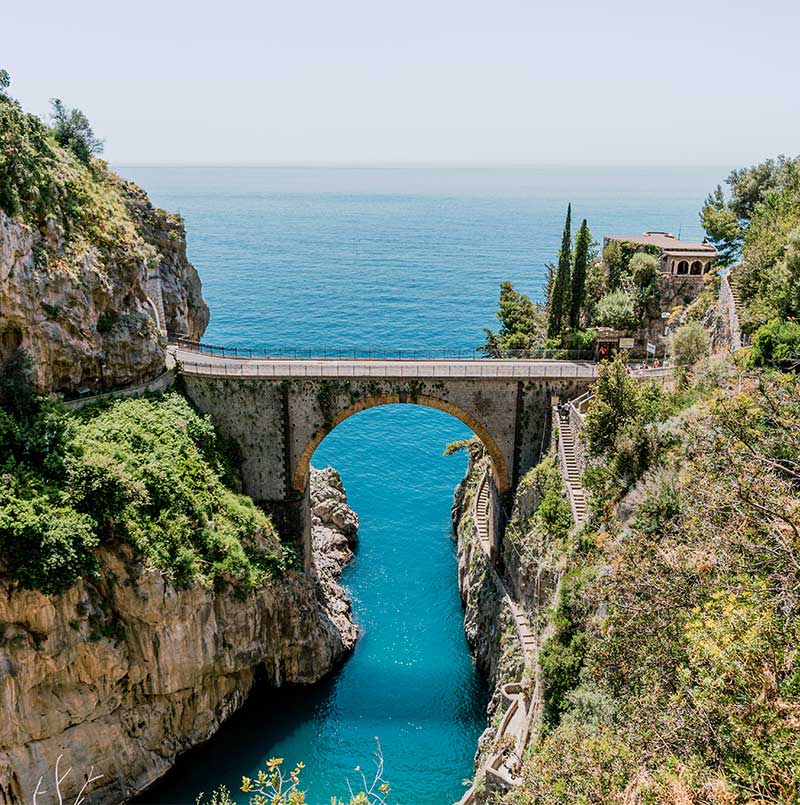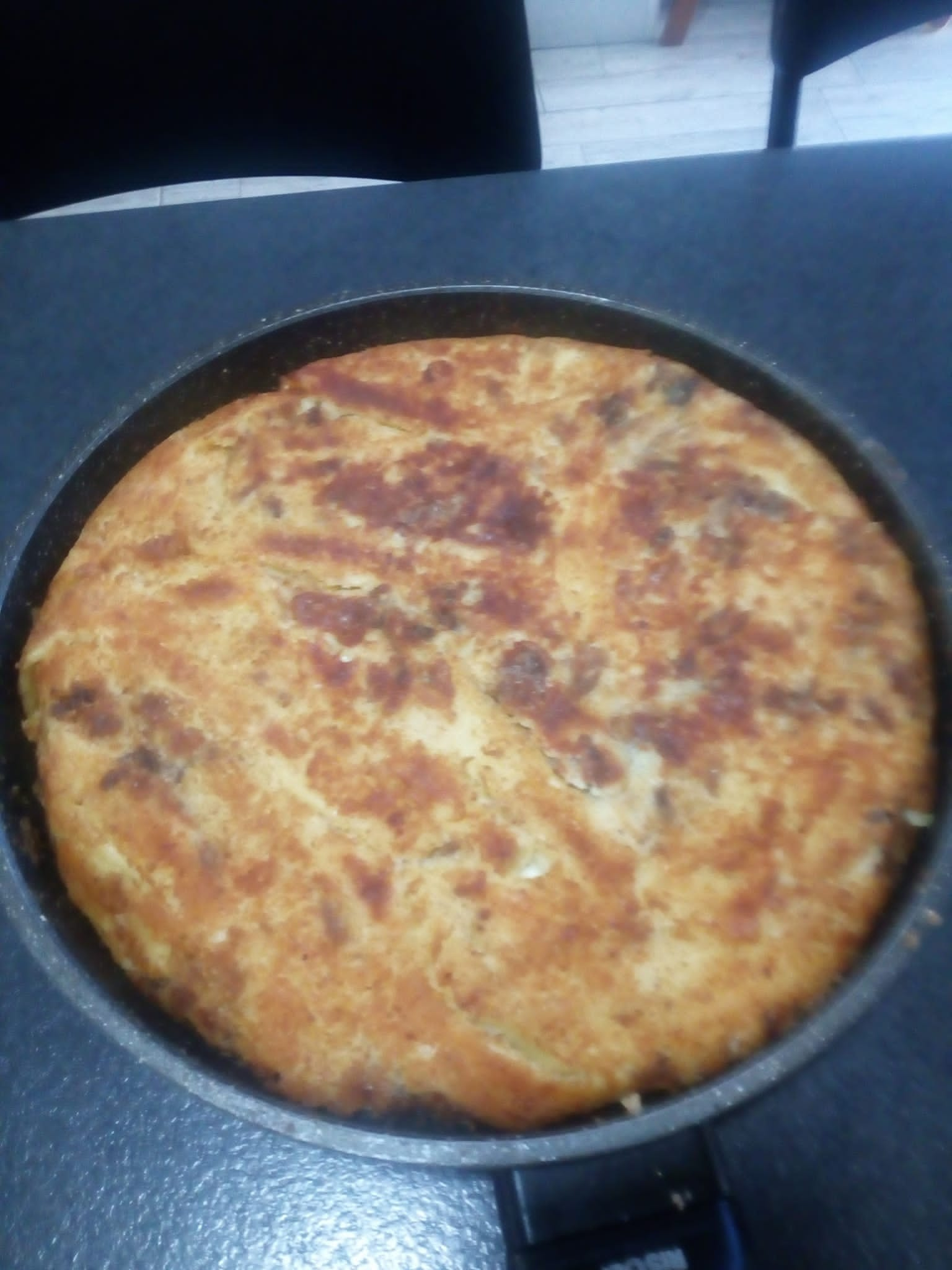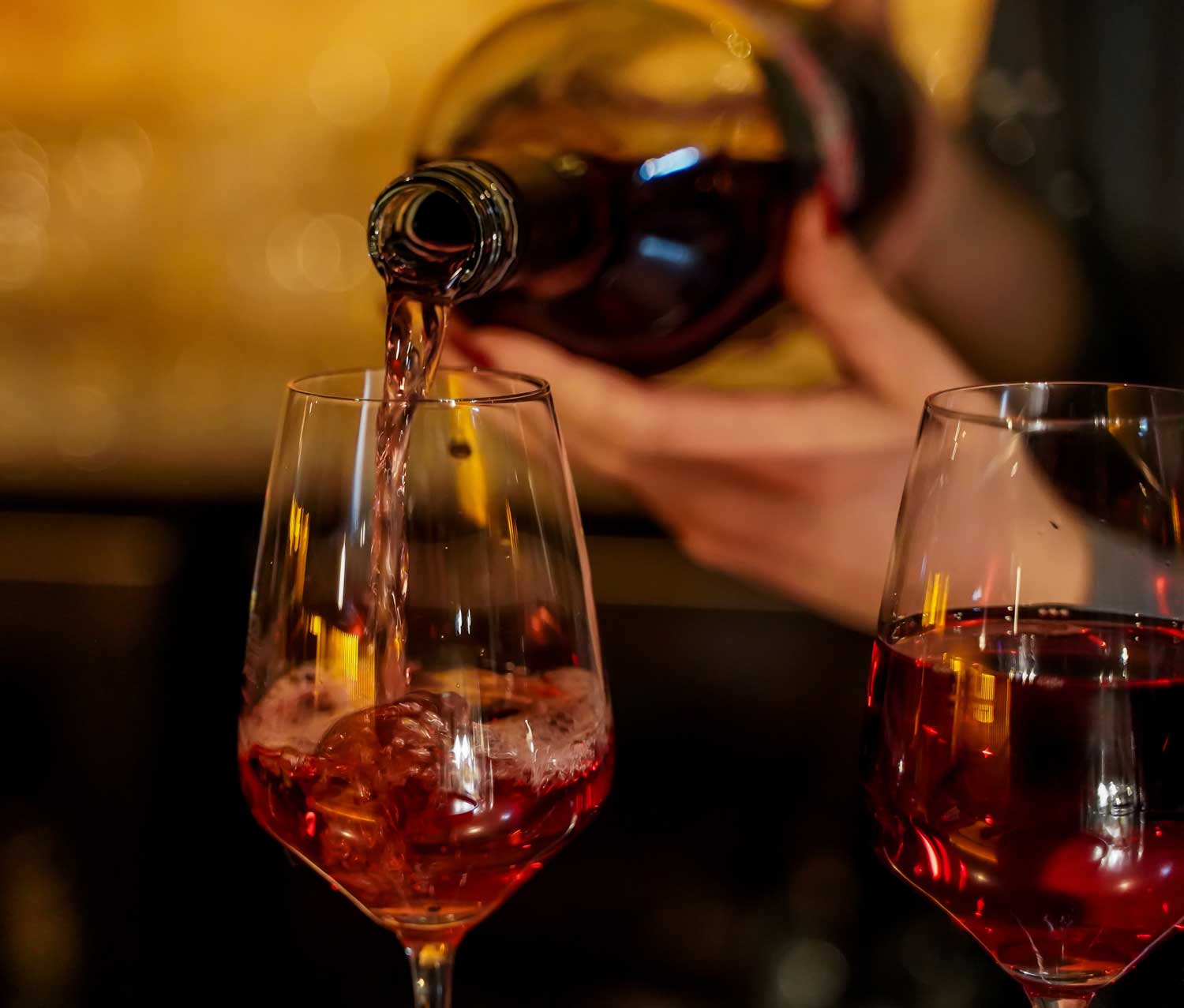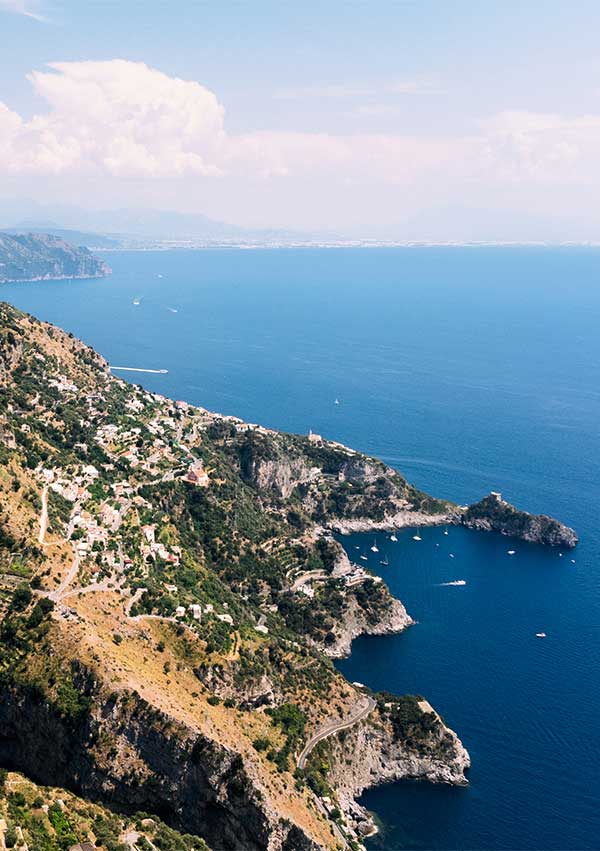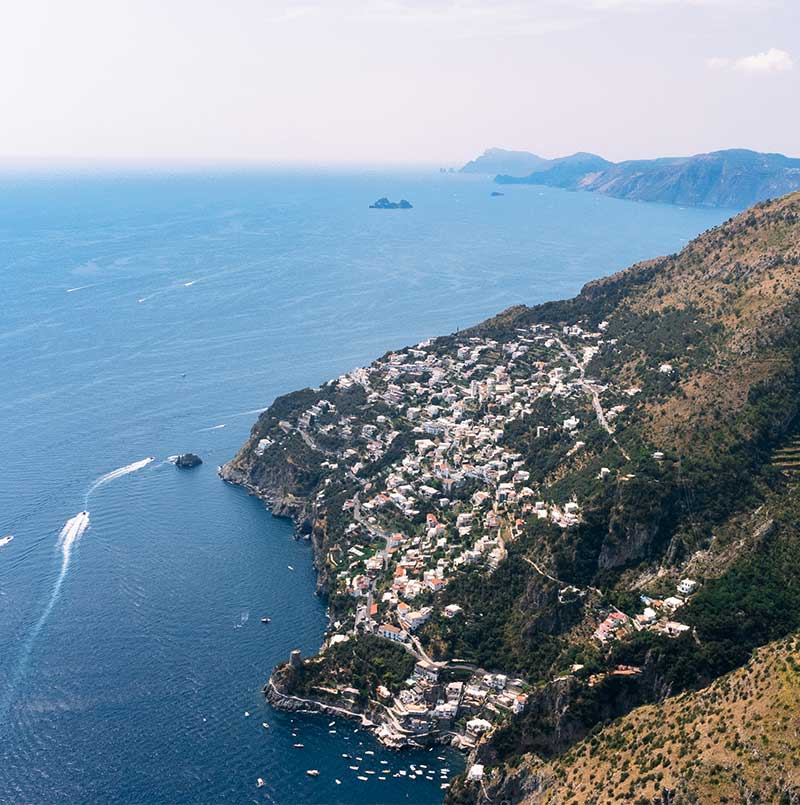amalfi coast
Furore
The village hotel with its village clinging to the sides of the mountain and overhanging the sea, offers its visitors an authentic and reserved atmosphere and breathtaking views.
Seven kilometers from the rocks of the Divine Coast, left the Amalfi State and along the hairpin bends of a road “among the most beautiful in the world”, you get to Furore.
Furore, it is offered to those who are able to appreciate the authentic. Paradise still little unknown, with its walks halfway up the coast, with its breathtaking views, the typical craftsmanship, the sweet climate, the private atmosphere, the most knowledgeable gastronomy, is there, within reach of those who still search for the “places of the soul”.
You will live a dreamy and at the same time disturbing atmosphere, where every look is already emotion and every thought is already a dream.”
The history of Furore
Roman fugitives pursued by barbarians, took refuge on these mountains and founded the first settlements: Scala, Ravello, Furore. Then from here they went down to the sea, until they became very skilled navigators. So the glorious Amalfi Republic was born.
Furore remained, for its particular conformation, a stronghold untouchable even at the time of the Saracen raids. Its inhabitants dedicated themselves in particular to sheep farming and crafts.
The Fiordo was a natural port, where flourishing trades took place and the ancient forms of industry developed: paper mills and mills fed by the waters of the Schiato stream, which descended from the Lattari Mountains. The name Furore came from the particular fury that the sea takes on in the days and nights of storm and the roar of the waves on the cliff and in the fjord, with frightening and deafening noises.
Some of the most important families have given their names to places and streets: Le Porpore, Li Cuomi, Li Candidi, Li Summonti.
The coat of arms of the ancient Terra Furoris Universitas is represented by a shield representing a gold column in blue field. Furore today counts four churches: San Giacomo, San Michele, Sant’Elia and Santa Maria della Pietà.
The three districts of Furore, Santo Jaco, Sant’Angelo and Sant’Elia, are marked by three coats of arms: the Pacifier, the Cat and the Cicala.
Discovering the Amalfi Coast


TREKKING TOUR
Spend a day discovering the beautiful paths through the Amalfi Coast and enjoy its breathtaking landscapes.


BOAT TOUR
Admire the Amalfi Coast from a fantastic angle, discover the hidden wonders and sail through its crystal clear waters.


WINE TOUR
Sip a good glass of wine to discover the wine tradition of Furore and the Amalfi Coast.
Gastronomy
The Amalfi Coast, as well as offering breathtaking landscapes and unique experiences, inebriates its visitors with its delicious cuisine.
The housewives of the ancient Terra Furoris produced pasta by hand and among the various formats stand the Ricci furitani, a sort of fusilli “round trip” passed on a striped tablet.
Traditional dishes
Furore boasts a varied and tasty local cuisine, among the typical products of these lands we find: mountain tomatoes, olive oil, dry earth potatoes, wild and fragrant herbs.
To try is the dish squid and potatoes, created by the farmer-fisherman of these lands. Traditional are also: the migliaccio, timbale of semolina and pork, the maritata soup, enriched with spontaneous and fragrant vegetables of the hill; the caponata, made with bread biscuit “freselle”, wet and seasoned with cherry tomatoes, anchovies and aubergines with olive oil.
Dessert
In the wide range of specialties typical of Neapolitan pastry, Furore inserts some varieties of desserts, which have within them the tradition and the scent of this hill courted by the sea and kissed by the sun.
In the Cicadas the almond paste, typical of the Mediterranean area, is enriched by the scent of a delicate rosolio obtained from the Prickly Pear: the “Nanassino”.
Delicacies as rare as precious are the varieties of fruit preserved under spirits: Sanginella grapes with anise, apricots with brandy, figs with rum. Furore beats on the wild with many other roses: blackberries, wild strawberries, fennel, locust beans, herbs.
A separate speech deserves the Elisir delle Janare, the liqueur of desire, based on raw celery, considered the prince of aphrodisiacs already at the time of ancient Rome.
Wine
In the small agricultural area of the Amalfi Coast the vineyard plays a historically prominent role. The scarcity of arable land, torn from the rock through terraces of amazing ingenuity, has imposed an intensive exploitation of the soil, as well as a very strict selection of crops.
Hence the primacy of the citrus grove and the “vineyard with fruits”, with vines initially leaning on living supports (almond and walnut), then entrusted to long poles – we are in the eleventh century – and, finally, grown on pergolas specially built with chestnut poles.
“These ridges, which, like all the hills of good wine, have their feet immersed in water, their faces kissed by the sun, the sinuous sides of a beautiful maiden, could not but be generous with their great lover, madly in love, who is the winemaker of this land.
Here live vines of noble lineage. Are the whites Coda di Volpe, Bianca Zita, San Nicola, Ripoli, Fenile, Ginestrella and the reds Pere ‘e Palummo, Serpentaria, Tintore, Taralluzzo, all worthy of great attention and worthy of entering the local wine production, that it obtained, a few decades ago the Denomination of Controlled Origin.
The wines currently produced – white, red and rosé – are well matched to the dishes of local cuisine. Their savory complacency makes them very pleasant. Berli means to live in the round the party that the places inspire, with an invitation to do… Furor.
So much so that Veronelli wrote: “You will drink fresh and joyful wines, capable of throwing all the sun and all the joy you have on your skin.”
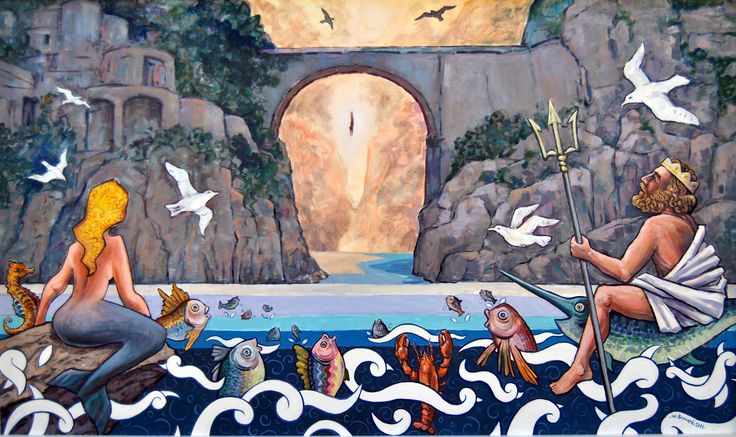

muri d’autore
Art and culture
“Muri d’autore” was born from the idea of connecting the natural environment with art.
Since 1980, paintings and wall sculptures that tell of traditions, rites and myths of the country have helped to make Furore one of the most evocative painted countries of Italy, making it an increasingly rich and interesting museum en plein air.


through the
Paths
Barbonera's Path
It starts from Agriturismo Serafina and enters the valley of Praia. The old home of Barbanera (a kind of astrologer lived to 50s) is soon reached. Just beyond the village of Praiano begins and the road, wich had become comfortable walk, Piazza Moresco and from there to the rolling stock.
Journey time 70 minutes
Abutabela Path
From Pino to St. Lazarus of Agerola, on the general Avitabile’s footsteps (abutabela of Peshawur). It starts from the Punta Scotelo. It penetrates into the throat until Rio Penise. It passes at the old powder magazine, ambedded in the rock on the steep sides of the canyon. Wedges of sea in the distance frame the horrid vision of the ravine that cuts through the mountains from the mountain to the Fiordo. The middle is the square of St. Lazaru, still permeated by the abutabela myth. “Oh blessed solitude! Oh lonely beatitudo”.
Jouney time 50 minutes
Path of the Crow's Nests
From Centena to Bomerano of Agerola, along the way of the bandits. Leave the rolling stock under the house of the cloak and at the junction of St. Alfonso turn right and climb among pergolas and hazel in Santa Barbara. High on the ridge assaulted by vegetations you can see the ruins of the hermitage. Enter, then, into the valley and you can easily get to the square of Bomerano.
Journey time 70 minutes
The path of Agave in bloom
From Punta St.Elia to Marina of Praia, in the middle of the “lines” of harvesters (fishing line: small area of the cliff, wich was sold in order to obtain grass). After leaving the walk of love, take the path that leads between Agavi, olive and fig trees of Pennola. Here survives the carob, between mastic and rosemary. A little bit further there is Grottole with its fortification. From here you descend the steeply path to Carritto to the Praia bridge, on the Amalfi Coast.
Journey time 90 minutes
Path of Monkfish Fox
From St. Elia to the fjord, along the old route of the farmer-fisherman. Passed the palace of Maccaronari, you come to the door and down between the characteristic “monazzeni”. The magic of these place is not to be described.
Journey time 40 minutes
The Crazed Bats Path
This path can become the continuation of the previous one. It starts from the fjord, along a path that penetrates in an orgy of green, cut and mill, along canals and locks and arrives at the mill: lonely, silent, wrapped in a nest of bats. Here the path turns right and climbs the cliff up to Punta Tavol: small plateau overlooking the valley. Further there is the San Michele’s church From here to the center of Conca dei Marini, Olmo square and the Santa Rosa monastery, on the Amalfi-Agerola road.
Journey time 30 minutes

